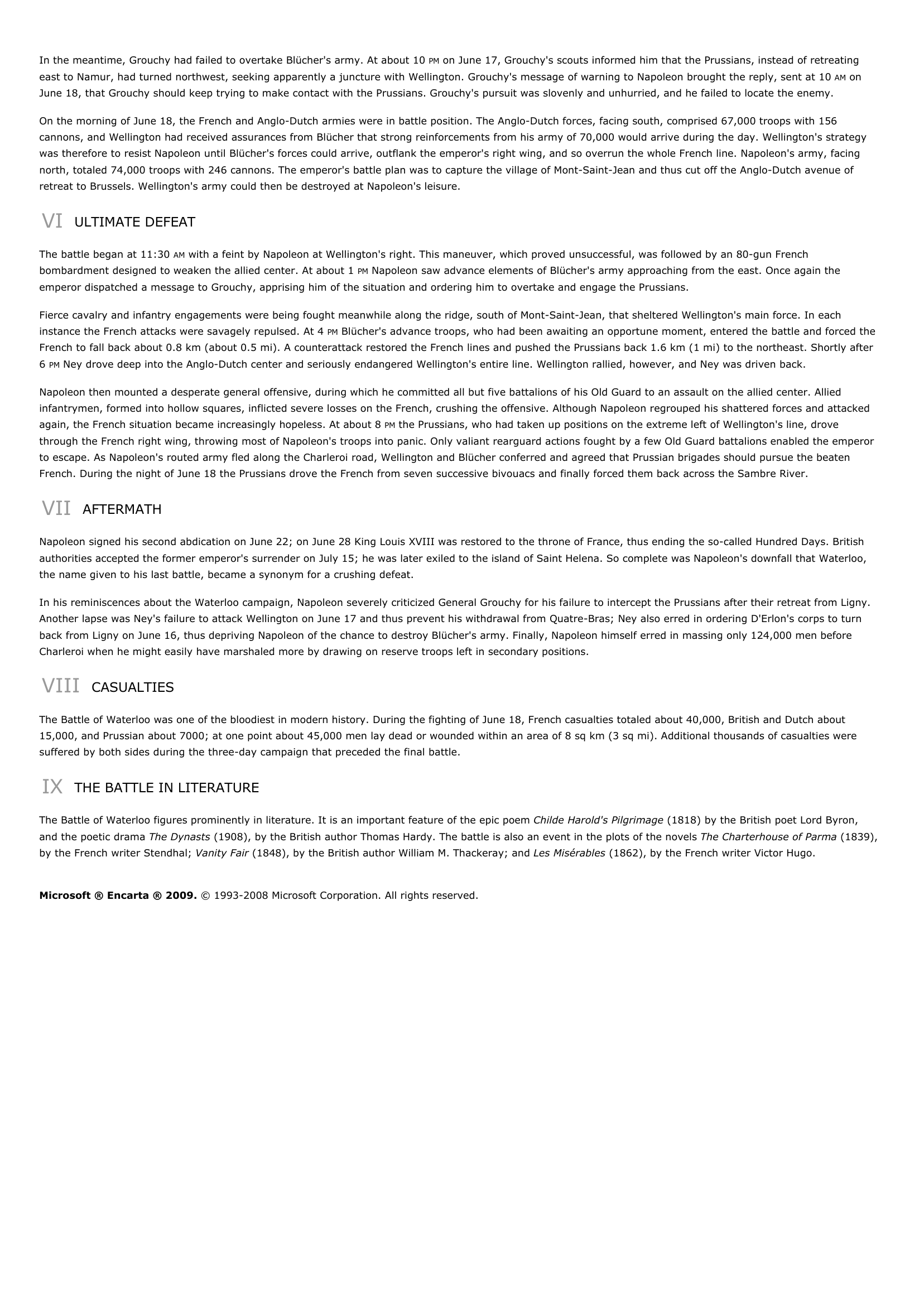Battle of Waterloo.
Publié le 03/05/2013

Extrait du document
«
In the meantime, Grouchy had failed to overtake Blücher's army.
At about 10 PM on June 17, Grouchy's scouts informed him that the Prussians, instead of retreating east to Namur, had turned northwest, seeking apparently a juncture with Wellington.
Grouchy's message of warning to Napoleon brought the reply, sent at 10 AM on June 18, that Grouchy should keep trying to make contact with the Prussians.
Grouchy's pursuit was slovenly and unhurried, and he failed to locate the enemy.
On the morning of June 18, the French and Anglo-Dutch armies were in battle position.
The Anglo-Dutch forces, facing south, comprised 67,000 troops with 156cannons, and Wellington had received assurances from Blücher that strong reinforcements from his army of 70,000 would arrive during the day.
Wellington's strategywas therefore to resist Napoleon until Blücher's forces could arrive, outflank the emperor's right wing, and so overrun the whole French line.
Napoleon's army, facingnorth, totaled 74,000 troops with 246 cannons.
The emperor's battle plan was to capture the village of Mont-Saint-Jean and thus cut off the Anglo-Dutch avenue ofretreat to Brussels.
Wellington's army could then be destroyed at Napoleon's leisure.
VI ULTIMATE DEFEAT
The battle began at 11:30 AM with a feint by Napoleon at Wellington's right.
This maneuver, which proved unsuccessful, was followed by an 80-gun French bombardment designed to weaken the allied center.
At about 1 PM Napoleon saw advance elements of Blücher's army approaching from the east.
Once again the emperor dispatched a message to Grouchy, apprising him of the situation and ordering him to overtake and engage the Prussians.
Fierce cavalry and infantry engagements were being fought meanwhile along the ridge, south of Mont-Saint-Jean, that sheltered Wellington's main force.
In eachinstance the French attacks were savagely repulsed.
At 4 PM Blücher's advance troops, who had been awaiting an opportune moment, entered the battle and forced the French to fall back about 0.8 km (about 0.5 mi).
A counterattack restored the French lines and pushed the Prussians back 1.6 km (1 mi) to the northeast.
Shortly after6 PM Ney drove deep into the Anglo-Dutch center and seriously endangered Wellington's entire line.
Wellington rallied, however, and Ney was driven back.
Napoleon then mounted a desperate general offensive, during which he committed all but five battalions of his Old Guard to an assault on the allied center.
Alliedinfantrymen, formed into hollow squares, inflicted severe losses on the French, crushing the offensive.
Although Napoleon regrouped his shattered forces and attackedagain, the French situation became increasingly hopeless.
At about 8 PM the Prussians, who had taken up positions on the extreme left of Wellington's line, drove through the French right wing, throwing most of Napoleon's troops into panic.
Only valiant rearguard actions fought by a few Old Guard battalions enabled the emperorto escape.
As Napoleon's routed army fled along the Charleroi road, Wellington and Blücher conferred and agreed that Prussian brigades should pursue the beatenFrench.
During the night of June 18 the Prussians drove the French from seven successive bivouacs and finally forced them back across the Sambre River.
VII AFTERMATH
Napoleon signed his second abdication on June 22; on June 28 King Louis XVIII was restored to the throne of France, thus ending the so-called Hundred Days.
Britishauthorities accepted the former emperor's surrender on July 15; he was later exiled to the island of Saint Helena.
So complete was Napoleon's downfall that Waterloo,the name given to his last battle, became a synonym for a crushing defeat.
In his reminiscences about the Waterloo campaign, Napoleon severely criticized General Grouchy for his failure to intercept the Prussians after their retreat from Ligny.Another lapse was Ney's failure to attack Wellington on June 17 and thus prevent his withdrawal from Quatre-Bras; Ney also erred in ordering D'Erlon's corps to turnback from Ligny on June 16, thus depriving Napoleon of the chance to destroy Blücher's army.
Finally, Napoleon himself erred in massing only 124,000 men beforeCharleroi when he might easily have marshaled more by drawing on reserve troops left in secondary positions.
VIII CASUALTIES
The Battle of Waterloo was one of the bloodiest in modern history.
During the fighting of June 18, French casualties totaled about 40,000, British and Dutch about15,000, and Prussian about 7000; at one point about 45,000 men lay dead or wounded within an area of 8 sq km (3 sq mi).
Additional thousands of casualties weresuffered by both sides during the three-day campaign that preceded the final battle.
IX THE BATTLE IN LITERATURE
The Battle of Waterloo figures prominently in literature.
It is an important feature of the epic poem Childe Harold's Pilgrimage (1818) by the British poet Lord Byron, and the poetic drama The Dynasts (1908), by the British author Thomas Hardy.
The battle is also an event in the plots of the novels The Charterhouse of Parma (1839), by the French writer Stendhal; Vanity Fair (1848), by the British author William M.
Thackeray; and Les Misérables (1862), by the French writer Victor Hugo.
Microsoft ® Encarta ® 2009. © 1993-2008 Microsoft Corporation.
All rights reserved..
»
↓↓↓ APERÇU DU DOCUMENT ↓↓↓
Liens utiles
- La charge des cuirassiers à Waterloo
- Waterloo
- BATAILLE DES LIVRES (La) [The Battle of the Books] (résumé & analyse) de Jonathan Swift
- Waterloo.
- STENDHAL (1783-1842) La bataille de Waterloo On se remit en marche.

































